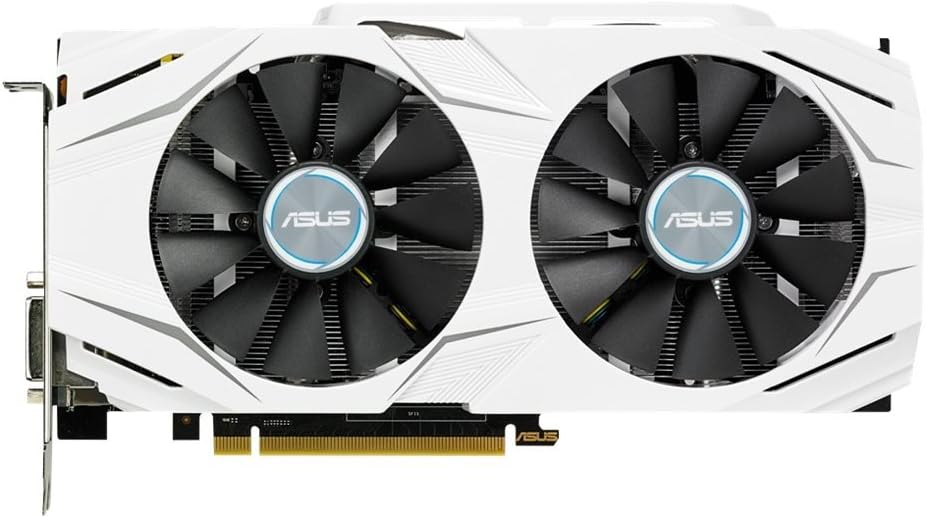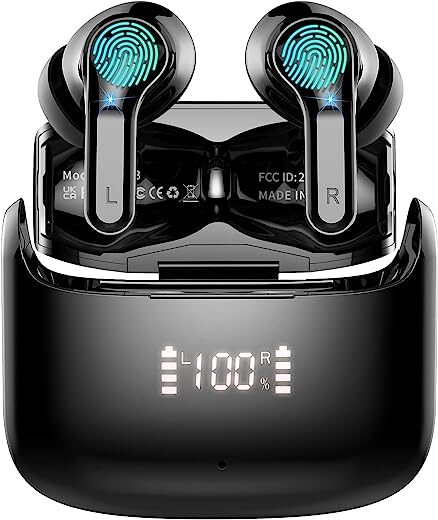
ASUS GeForce GTX 1060 6GB Dual-Fan OC (DUAL-GTX1060-O6G) Price comparison
ASUS GeForce GTX 1060 6GB Dual-Fan OC (DUAL-GTX1060-O6G) Price History
ASUS GeForce GTX 1060 6GB Dual-Fan OC (DUAL-GTX1060-O6G) Description
ASUS GeForce GTX 1060 6GB Dual-Fan OC (DUAL-GTX1060-O6G) – Unleash the Power of Gaming
The ASUS GeForce GTX 1060 6GB Dual-Fan OC is a powerful graphics card designed for gamers who demand high performance and reliability. With advanced technology and remarkable features, this graphics card is a game-changer for your desktop setup. Whether you are into first-person shooters, role-playing games, or graphic-intensive applications, the GTX 1060 offers optimal performance and stunning visuals. Compare prices now!
Key Features of ASUS GeForce GTX 1060 6GB Dual-Fan OC
- High Memory Speed: Operates at an impressive speed of 1809 MHz, ensuring smooth gameplay with minimal lag.
- 6GB GDDR5 Memory: With 6000 MB of memory, this graphics card provides ample space for high-resolution textures and graphics.
- Dual-Fan Cooling System: Featuring a dual-fan design, this card promotes effective heat dissipation, allowing for longer gaming sessions without overheating.
- Versatile Connectivity: Equipped with a USB 2.0 port and PCI Express interface, ensuring compatibility with a wide range of devices.
- Compact Design: Measuring 9.53 x 1.69 x 5.12 inches, it is compact enough to fit into most standard desktop cases.
- Gamers’ Choice: Specifically designed for gaming, this graphics card is a preferred choice among gamers for its performance and reliability.
Price Comparison Across Suppliers
When shopping for the ASUS GeForce GTX 1060 6GB Dual-Fan OC, price variations can occur across different retailers. This graphics card is commonly found in the range of $250 to $300. Our price comparison tool helps you find the best deal tailored to your budget. Make sure to check multiple suppliers to benefit from promotions and discounts.
6-Month Price History Trends
Analyzing the 6-month price history chart reveals some interesting trends. Over the past few months, there’s been a steady decline in prices, particularly around major sales events. This decline offers a strategic opportunity for budget-conscious gamers looking to upgrade their systems.
Customer Reviews: Pros and Cons
In customer reviews, users consistently praise the ASUS GeForce GTX 1060 6GB for its excellent performance in 1080p gaming. Many users appreciate the dual-fan cooling system, which efficiently manages heat, allowing for extended gameplay without throttling. The compact design also receives commendations, making it a great fit for smaller setups.
However, some users have noted that it can be outperformed by newer technology, particularly in demanding gaming environments. A few have mentioned driver issues upon installation, requiring troubleshooting to achieve optimal performance. Overall, customer feedback indicates satisfaction with the card’s capabilities, making it a solid investment for gamers.
Explore Unboxing and Review Videos
If you’re considering the ASUS GeForce GTX 1060 6GB Dual-Fan OC, we recommend checking out various unboxing and review videos online. These videos provide a firsthand look at the installation process, thermal performance, and gaming benchmarks. Seeing the graphics card in action can help in making an informed purchase decision.
Why Choose the ASUS GeForce GTX 1060?
The ASUS GeForce GTX 1060 6GB Dual-Fan OC stands out in a crowded market of graphics cards. It combines a powerful NVIDIA chipset, substantial video memory, and an effective cooling solution. These features make it an excellent choice for both casual users and serious gamers alike. With the ability to handle modern games effectively at high settings, it is perfectly suited for anyone looking to elevate their gaming experience.
Additionally, this graphics card’s longevity in the market speaks volumes about its reliability and performance. With continuous software updates and community support, users can expect ongoing improvements in functionality, keeping pace with evolving gaming demands.
Final Thoughts
In summary, the ASUS GeForce GTX 1060 6GB Dual-Fan OC graphics card is an excellent investment for gamers focused on performance without breaking the bank. With its solid features, favorable customer reviews, and competitive pricing, it makes sense to consider this option for your gaming needs.
Ready to enhance your gaming setup? Don’t miss out on the opportunity to secure this powerhouse at the best price! Compare prices now!
ASUS GeForce GTX 1060 6GB Dual-Fan OC (DUAL-GTX1060-O6G) Specification
Specification: ASUS GeForce GTX 1060 6GB Dual-Fan OC (DUAL-GTX1060-O6G)
|
ASUS GeForce GTX 1060 6GB Dual-Fan OC (DUAL-GTX1060-O6G) Reviews (7)
7 reviews for ASUS GeForce GTX 1060 6GB Dual-Fan OC (DUAL-GTX1060-O6G)
Only logged in customers who have purchased this product may leave a review.








Alex S. –
Understandably most customer reviews of this ASUS 1060 Dual OC and other graphics cards are written from the viewpoint of gamers and certainly contain a lot of useful benchmarking, as well as how they perform at 1080p resolution. At the same time, periodically you come across an inquiry here and in forums about what is necessary for photo editing. With all due respect, many of the answers are obviously from casual photographers having limited experience with what I would call “serious”, let alone professional, post-processing. I am not a professional photographer, just a “serious” amateur, but while I don’t profess to have all the answers I thought it might be helpful for others out there if I share my own conclusions.
First, some background. I have four builds “under my belt”. Yes, I know that doesn’t make me a tech expert either, but still reasonably knowledgeable. For reference, current build is ASUS Z97-Pro ATX mobo, i7 4790K @ 4GHz, 32 GB GSkill F3-1866 RAM, Corsair RM 750 power, two SanDisk Extreme Pro SSD’s (one 480GB for Win 10×64 and executables, the other 240GB for primary photo storage), and a couple of WD Blue HD for other storage. Current (new) graphics card is this ASUS 1060 6 GB OC, prior card was an EVGA 760 SC with 4GB vram (both purchased from Amazon). Card is mounted in a PCIe 2.0 x 16 slot. A Display Port connection was used with both cards because of the potential for greater color depth compared to HDMI (for now that is limited by Windows and the nVidia driver) and the ability to daisy-chain monitors. The monitor in both cases is an ASUS PA279Q ProArt (IPS, native res 1440p [2640×1440], 99% Adobe RGB, 10 bit color with 14 bit look-up table) calibrated with the Spyder Elite 4 Colorimeter. Video driver is nVidia 372.70 running in 32 bit desktop color depth, 10 bpc output color depth, and full output dynamic range. The only additional OC I have applied is the rather modest “Game” boost on ASUS Tweak II (because for my purposes I don’t need more, probably don’t even need this boost). Overall not the absolute fastest system, but no slouch either.
The photo editing software I use includes Adobe Lightroom CC, Adobe Photoshop CC, version 10.5.1 of On1 Photo 10, and some of the Topaz plug-ins. For now, most of my post-processing editing begins in LR, with side trips to the others. Note: Both the order of editing and experience with the above graphics cards may change once On1 release Photo Raw this fall. Most of my photos are at moderately high res (24 MP), and I typically edit them in 16 bit. Often I will spend one to several hours editing a single photo – with a number of layers and final size up around 40 or 50 MP. (Don’t laugh: Professionals sometimes spend several days. How long do you gamers spend gaming?) I have edited in both 1080p and 1440p, and prefer the latter for the better resolution (masking, sharpening) and greater screen real estate. So what have I found?
Lightroom CC: The LR editing module, like Photoshop (below), is optimized to use a compatible GPU. Open GL 3.3 or higher and 2 GB vram is suggested for high resolution photos [Note: Both of the cards being reviewed meet these requirements]. As long as you stay in LR you are performing non-destructive edits to your Raw file (assuming you started with Raw), and these edits are written to a catalog rather than incorporated into the original file. Perhaps because of this, I have seen little difference in speed between the two GPU’s when editing with the sliders at either 1080p or 1440p. I do notice some improvement in speed with the 1060 at 1440p (vs the 760) using the graduated and radial filters and the adjustment brush. Thumbnails seem to load more quickly with the 1060 as well.
Photoshop CC: Not surprisingly, the PS GPU requirements are similar to LR. But unlike LR, which will automatically use a suitable GPU, in PS you must go to Edit>Preferences>Performance, turn on the “Use Graphics Processor” box, and then decide on the Advanced Settings (mine is set to Advanced Drawing with all options selected). When using Adobe Camera Raw, the findings are much the same as with LR. Once you take a Raw file into PS itself, though, you are rendering it into a PSD file – which can take longer to process than a Raw file. When I do go to PS it is mostly to use things that are unavailable elsewhere – like adjustment layers, Content-Aware crop, the Blur Gallery, Gradient Fill, Smart Filters, text layers or Lumenzia (by Greg Benz). According to Adobe, only certain functions are GPU accelerated (see Adobe Support). Nevertheless, there seems to be a definite improvement in responsiveness with the 1060 (in either resolution) when using multiple layers and especially in “round trips” via a smart filter to both On1 Photo and Topaz plug-ins. I used to avoid going back and forth from PS to these other programs because it was so sluggish. Based on this, I suspect the GPU accelerated functions like Blur Gallery and Smart Sharpen will also speed up, though I haven’t tested them yet.
On1 Photo 10.5.1: Here there is the most marked difference between a GTX 760 and 1060, probably because this is one of the most graphics intensive photo editors. The program is supposedly able to use “modern” GPU’s (Open GL 2.0 or better) with 256 MB vram and 4 GB system RAM specified (8 GB when used as a PS plug-in). This spec alone makes me wonder if On1 Photo is relying more on the CPU. In Preferences, I have the program set to use 75% of system RAM and 75% of vram, with a 5 GB cache. As with PS, once you take a Raw file into On1 you will be rendering it as a PSD file. On1 Photo is a program I want to love, but as with other reviewers I find there are still bugs in the interface and sluggishness in its performance. In fact, using the GTX 760 at 1440p makes the program very slow indeed. Layered effects (I mostly do not use presets) load slowly and it takes more time than it should to save your work – which you should do frequently because the program has a tendency to crash when you layer up too many effects without saving. And forget using the masking bugs with the 760 at 1440p – they stutter and often freeze up. [These problems are somewhat less, except for the occasional crash, when using the 760 at 1080p.] What about the GTX 1060? Here everything changes! Multiple effects load in the blink of an eye and the masking bugs work as they should, even at 1440p. (I can’t comment on the program crashes as I haven’t used this 1060 for very long yet.) All of a sudden it becomes a pleasure to use On1 Photo 10, and that’s good because this program offers some fantastic and easy to use editing tools for dynamic contrast, tone and color adjustments, stylizing and otherwise “finishing” your photo.
Note: On1 Inc. will be releasing On1 Photo Raw later this fall. It is a raw processor with no cataloging (vs LR), allowing non-destructive editing and use as a standalone, plug-in for LR and PS, or as a host app. It will be “tuned for today’s graphics processors”, with a requirement for Open GL 3.3 with minimum 512 MB vram and 4 GB system RAM (8 GB when used with PS), and is being billed as “the world’s fastest . . . raw processor and photo editor available.” I can’t wait to see how Photo Raw performs with the ASUS 1060 in 1440p resolution!
Topaz plug-ins: Topaz Labs has a number of useful photo editing plug-ins for LR and PS, as well as several that do not require a host editor. They recommend at least 4 GB of system RAM and 1 GB of vram (2 GB for optimal performance). GPU requirements vary by product, from Open GL 2.1 to 3.3, and certain products will crash unless these specifications are met. All of the Topaz products I tested ran acceptably with the GTX 760 in 1440p, although the more graphics-intense were a bit slow. Running with the 1060 in 1440p they are noticeably faster and more pleasing to use.
Summary: While this is by no means an exhaustive comparison of the GTX 760 vs 1060 for photo editing, it is apparent that resolution is the key factor when it comes to determining your experience. Many photographers and gamers are shifting to larger monitors and 1440p (or higher) resolution. Once you try it (assuming adequate GPU support) you won’t want to go back. The 760 and 1060 are several generations apart, and since I don’t purchase a new graphics card every few months I can’t be certain what is the minimal step up from the 760 for acceptable 1440p performance. I can state with confidence that the ASUS GTX 1060 6 GB Dual OC will do the job. Moreover, at the moment this card is at the “sweet spot” when it comes to performance vs price. For benchmarking purposes running Heaven 4.0, my ASUS 1060 in Game Mode at 1440p runs at avg. 71.9 FPS (just saying: I know I’m not editing videos), with a GPU clock of 1886 and score 1811 at max. temp of 82C with auto fan in a well-ventilated ATX tower. On FurMark 1.18, again in Game Mode, the score was 5280 at avg. 88 FPS and max. temp of 71C using the 1440 preset, 2560×1440 full-screen resolution. The ASUS card seems stable in both tests.
Bottom Line: The GTX 1060, 70 and 80 line, with its Pascal architecture, is very attractive to gamers (and I hope I have shown it should be to serious photographers, as well). Since you really don’t need the speed (or cost) of a 1070 or 1080 for photo editing, the 1060 would seem to be the perfect choice. I have found ASUS products to be well-built and reliable – as noted, I also have an ASUS mobo and monitor. The ASUS 1060 fits nicely in my ATX tower and doesn’t override two slots as is the case with some other cards. Moreover, the dual fans are quiet and keep temps down. I also appreciate the pair of HDMI and Display Port connectors. The only caveat – Tweak II could use some tweaking. You might prefer MSI Afterburner if you are going to do any serious oc. My Conclusion: Forget the forum advice about $80 graphics cards and so-so CPU’s for photo editing. Pick up one of these ASUS GTX 1060 cards (preferably the 6 GB version) if you can and if your CPU won’t be a bottleneck. You won’t go wrong!
Tim W. –
Tarjeta muy sólida, poco ruidosa y con un rendimiento muy aceptable. Yo la he dado caña jugando a Doom Eternal y sin problemas.
しらたま –
This graphics card is an excellent choice for 1080p gamers! It provides steady frame rates and I can play at ‘Ultra’ settings in all the titles I play. The GTX 1060 6GB still represents one of the best of the mid-range graphics cards available for the price, and if crypto mining did not inflate the price of the RX 580 GPU’s then maybe there would be more equal competition. That being said, my stream of thought was from a full month ago (Sept/2017), and at the time of purchase I paid $364.99 for this 1060 and I admittedly was looking at some RX 580 8GB cards. But they were all around $400-450. So, at the time it did not make sense, but since a month has passed on this purchase there has been some market changes again.
While doing some research as I now write this review I am seeing more RX 580’s in the price range of $350-400, and admittedly I would recommend the RX 580 in most scenarios over the GTX 1060. Performance wise they are pretty much 100% equal at 1080p gaming, Nvidia cards pull ahead a bit in some titles, while AMD pulls ahead in others, but for the most part they provide identical performance. Software updates have helped the RX 580’s performance quite a bit since launch. If you are a new system builder and looking to buy a new monitor etc. the RX 580 is quite compelling, especially for a gaming dedicated build. Free-sync monitors are far cheaper than high refresh rate G-sync monitors, and whereas the RX 580 can be set up in Crossfire the GTX 1060 cannot do SLI.
So, seeing my 5/5 star review and reading the last paragraph slamming into the GTX 1060 and praising the RX 580 you may question my 5 star rating. But I will explain why even today I still would have made the same choice I did 1 month ago.
1- I already have several systems, all of which have high-end Nvidia graphics cards, but the purpose of this computer was to have a mid-range compact ITX gaming PC, I was not even considering a GTX 1070, 1080, or 1080 Ti. I just wanted steady 70FPS at 1080p ‘Ultra’ settings. At the time of purchase, this Asus GTX 1060 Dual OC Series 6GB was the best priced full-length graphics card that would fit in my case. The RX 580 I would have considered was at the time over $430, making the 1060 the better price to performance option.
2- I already own a 144hz G-sync 1ms response time gaming monitor. So, therefore, ruling out a RX 580 that already cost more money than the 1060.
3- And lastly as this system is based on an ITX motherboard, even if SLI was enabled on the GTX 1060 I could only ever put 1 GPU in my system anyways. So, a Crossfire setup had no bearing on my decision.
GAMING: Frankly I am tired of reading on tech forums how people don’t recommend a GTX 1060 for 1080p gaming. And that to play at ‘Ultra’ settings you need at least a GTX 1070. That simply is not true. I have a system with a GTX 1080 yet I pretty much exclusively game on my system with a GTX 1060 6GB (paired with an i7-6700k and 16GB of RAM) and I play all my games at 1080p Ultra settings on a my 144hz G-sync monitor, and yet I almost never get lower than 70FPS. Granted some games like Witcher 3 will fall back with Anti-Aliasing at its highest settings but other than maybe dialing that back I know you can leave all other settings at ‘Ultra’. I primarily play Battlefront, BF4, BF1, Shadow Of Mordor, GTA V, Watchdogs 2, and Assassins Creed (all of them), at 1080p Ultra settings with no issues what so ever.
So, in conclusion, I stand beside my decision to buy this Asus GTX 1060 6GB. It give’s me the performance I was expecting out of it and I am very happy with this purchase. I have yet to try and overclock it, but I am interested to see if I can squeeze out some additional performance from this GPU, which is more of a budget GTX 1060.
As I said with RX 580 8GB cards finally coming down in price I realize that many of you will be choosing it over a 1060, but if you ignore Crossfire and Free-sync monitors these cards will give you in-game performance so similar that you would never know them from one another. So, I stand by my choice and I encourage you all to choose which makes the most sense for you to buy. I am happy with my decision and although I did not choose this Dual Edition card for its color, it matches my white build perfectly, my decision was made on the price I bought it at. But to those of you considering this graphics card I can highly recommend it!
oreques –
Hallo zusammen,
ich habe die Asus GeForce GTX 1060 Dual OC 6GB bestellt.
Zunächst es handelt sich um die ab Werk übertaktete Version. Standard ist Sie aber im Basis Takt unterwegs, wenn Ihr in den OC Modus möchtet benötigt Ihr die Software “ASUS GPU Tweak II”, damit könnt Ihr dann in den Gamingmodus schalten und die höhere Taktung nutzen oder individuell anpassen.
Was mir bei der Karte besonderns gut gefällt ist die Kühlleistung. Auch unter Last ist die Geräuschkulisse erträglich. Im Gegensatz zu meiner älteren PowerColor Radeon HD6870 1GB GDDR5 PCS+, ist die Karte dank der zwei Lüfter wesentlich leiser.
SoVi –
まず注意点。
写真によっては2スロット占有のビデオカードに見えますが
実際は2.1スロットであり、3スロット使う可能性が高いです。
ですが、ケースから何からデザインを重視しているのか
細かいところまでセンスを感じる商品になっております。
セミファンレスと言われるビデオカードとは違い
常時ファンは回っていますが
モニターのすぐ横にパソコンを置いている方以外は
ほとんど音を感じないほど静かです。
ケースファンを利用している方は
ケースファンのほうがうるさいと思うくらいでしょう。
※必要な時はそれなりの音が出ますが。
コイル鳴きもほとんどなく
常時回転ファンというデメリットを意識して
「静音」へのこだわりはしっかり感じます。
10シリーズ入門には余りある素晴らしい商品です。
Jon –
Good product would recommend
Alex S. –
Why I bought this card: I needed a card to put in fairly budget rig I was building, and this was one of the cheaper cards available at the time.
TL;DR : A very solid card, overclocks nicely, had no temp problems while gaming, fairly quiet. Definitely would recommend.
Pros:
-Good Cooler for the price
-Plug and play, all you need are the Nvidia drivers and the card will work just fine.
-GPU Tweak II is easy to use and gives full control over the performance of the card.
-Overclock like beast, max OC was 2062 MHz, average OC was 2025 MHz.
-2 HDMI ports, good not only for VR, but also for those who do not have any DP capable monitors.
-No coil whine
Cons:
-Shroud feels cheap
-Fans on the louder side
-The presets in the card management utility(GPU Tweak) are lackluster, make your own profiles for best performance.
Other thoughts: For the 275$ I paid for this card at the time of purchase I expected some slightly better fans, though the current one get the job done fine.
Full Review:
Shipping and Packaging:
Card shipped very fast, even though amazon predicted that it would take up to two weeks to ship, I got it in three days. The packaging was undamaged and very well done, with foam padding all around the card to prevent damage, though even the outer box in which the card was shipped was undamaged.
First Impression:
The card had an average weight at this length. The white plastic shroud felt on the cheaper side, though this is to be expected on a 1060 25$ above MSRP. The fans looked and felt like solid, medium quality fans. There is no back plate, but at this price that is the standard.
Installation:
Nothing out of the ordinary, card went into the pci-e slot with no issues and the 6 pin power connector had no problems going in either.
General Use:
The card performed very nicely after simply installing the latest drivers from Nvidia, so anyone looking for a plug and play card, you will find this card very satisfactory in that regard. The card will handle games at 1080p like the average GTX 1060, so I won’t bother posting the benchmarks, because they are available from many different sources.
Different Modes & Overclocking:
Initially I was going dock this card a star for being nothing out of the ordinary in all of my tests, that is until I got to use GPU Tweak 2 to overclock the card and play around with the available presets. This card comes with three presets: Silent Mode, Gaming Mode and OC Mode, though you can add your own custom profile. Silent mode does its job well, it keeps the card as silent as possible, though this does prevent the card from getting its max performance to keep the card cooler. I used this for low intensity gaming and movie watching and it was silent throughout my experience. Gaming mode is nothing impressive; it will allow you to handle most modern games at 1080p without a hitch, but the fan profile on this is mediocre and the card will throttle after a few hours of intensive gaming. The OC mode is lackluster; yes it does boost the card to a higher frequency (1999 MHz) than gaming mode(1974 MHz) but it’s not by much, and it barely touches the power limit, resulting in frequent stutters in my benchmarks. The fan curve on this is the worst of the three modes, and the card throttled down quite a bit after just 1.5 cycles of Unigine Heaven. Where this card truly excels is in the custom profiles category: I managed to dial in a 2062 MHz overclock on this card, which throttled down to 2025MHz due to the power limit, though 2025Mhz on a 1060 is still nothing to scoff at. Adjusting the fan curve, power limit and voltage was very easy, and to make things easier, the power limit and temp target are coupled, so raising the power limit will automatically raise the temp target for you ass well. though at high rpm, these fans are very noisy, but not the loudest ones I’ve heard on a graphics card before. On a final note for this section, even though it seems I’m ripping this card a new one, its more me complaining about he quality of presets for this card. The card is advertised with a Boost Clock of 1806 MHz, and the fact that this card has 150 MHz OC presets that are(mostly) stable is amazing on its own. Overall, a 200+ MHz final overclock over the advertised boost is awesome.
Closing Thoughts:
This card is very good for its price, so set your expectations accordingly. Since I only purchased one of this card, I do not know whether I just got very lucky to have a very high quality GPU in mine or whether the GPUs in these cards are consistently of a very high quality,so I cannot say whether it will perform like a premium card every time. Regardless, I would recommend installing GPU Tweak II alongside this card and using it to get the max performance out of this card every time.